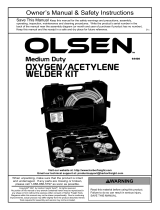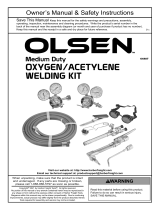Page is loading ...

F12-859-G
April, 2007
INSTRUCTIONS for
R-52, R-52-200, R-5210 and R-99
HIGH-CAPACITY STATION REGULATORS
These INSTRUCTIONS are for experienced operators. If you are not fully familiar with the principles of operation and safe prac-
tices for oxy-fuel gas equipment, we urge you to read our booklet “Precautions and Safe Practices for Welding, Cutting and
Heating,” Form 2035. The same information appears in the Oxy-Acetylene Handbook which may be purchased from any ESAB
distributor. Do NOT permit untrained persons to operate this equipment. Do NOT attempt to operate this equipment until you have
read and fully understand these instructions. If you do not fully understand these instructions, contact your supplier for further
information.
The regulators covered by these instructions are listed by Underwriter’s Laboratories only when used in combination with parts
manufactured by ESAB Welding & Cutting Products to the specifications on file with Underwriter’ Laboratories, Inc., and when
they are used in the gas service for which they are designed and listed. The use of other parts that cause damage or failure to the
equipment will void the manufacturer’s warranty.
Table 1 - Specifications
Max.
Regulator Nominal Max. Delivery Inlet &
Gas Capacity Inlet Pressure Pressure, Outlet
Model Part No. Service ft
3
/hr (m
3
/hr) psig (bars) psig (bars) Connections
Oxygen
R-52 20A16 Oil-free Air, 10,000 (283) 350 (24.1) 150 (10.3)
or Inert Gases
R-52-200 2117105 Oxygen,
Oil-Free Air, 10,000 (283) 350 (24.1) 200 (13.8)
or Inert Gases
Fuel Gas
R-5210 524193 including 2,000 (57) 15 (1.0)* 12 (0.8) 3/4" NPT
Acetylene
Fuel Gas
R-99 04X50 except 3,000 (85) 350 (24.1) 40 (2.8)
Acetylene
*If using fuel gas other than acetylene with the R-5210 regulator, the maximum allowable inlet pressure is 150 psig (10.3 bars).
3. Before connecting the regulator, open the station
valve slightly for an instant (this is termed “crack-
ing the valve”). This will blow out dust, dirt or any
foreign substance that may have collected while
installing the filter and piping for connection of the
regulator.
Never crack a gas supply valve near combustible
material or a source of flame.
4. After connecting regulator, back out (turn counter-
clockwise) the pressure-adjusting screw until it
turns freely.
I. OPERATING INSTRUCTIONS
A. TO CONNECT
R-52
1. A suitable line filter (P/N 2116734 is recommended)
should be connected between the station valve and
the regulator, 3/4-in. extra heavy pipe free of oil and
grease should be used. Teflon tape or paste or an
approved pipe compound must be used on all pipe
threads.
2. Standard 3/4-in. pipe unions should be installed at
each end of the regulator so that it can be removed
conveniently from the piping system for general
maintenance work.
!
CAUTION
®
Be sure this information reaches the operator.
You can get extra copies through your supplier.
!
CAUTION

2
5. Open the station valve slowly.
6. Test all connections with Leak Test Solution that is
suitable for oxygen service, such as P/N 998771 (8
oz. container).
R-5210 and R-99 Regulators:
The instructions are the same as above except that a
suitable line filter for fuel gas (P/N 2116339 is recom-
mended) should be installed just ahead of the regulator.
The fuel gas piping system should also include a suit-
able hydraulic back-pressure valve. OXWELD H-9 or
H-11-6M is recommended when using acetylene. OX-
WELD H-19 or H-12-6M is recommended when using
fuel gases other than acetylene such as natural gas,
propane, hydrogen, etc.
B. TO ADJUST PRESSURE
To increase delivery-pressure, turn the pressure-adjust-
ing screw to the right (clockwise). To decrease delivery-
pressure, turn the pressure-adjusting screw to the left
(counterclockwise). The torch oxygen (or fuel gas) valve
(and any other valve in the line between the regulator
and torch) should be open whenever you are adjusting
delivery pressure. If they are not open, you will not get a
true work-pressure reading on the delivery-pressure
gauge.
C. TO RELEASE PRESSURE
If work is to be stopped for a half-hour or more, you
should release all pressure from the regulator as fol-
lows:
1. Close the station valve.
2. Open the torch valve (oxygen valve if using the R-
5210 or R-99) until the regulator gauge hand returns
to the pin.
3. Release the pressure-adjusting screw by turning it
to the left (counterclockwise) until it turns freely.
4. Close the torch valve.
Always follow the steps outlined above before you re-
move a regulator from a station. If the regulator is to be
out of service for several days, or longer, turn in the pres-
sure-adjusting screw enough to move the seat off the
nozzle.
II. MAINTENANCE INSTRUCTIONS
If the regulator does not operate properly, stop work
immediately and investigate the cause of the malfunc-
tion. Maintenance and repair work must be performed
only by an experienced and qualified person. Do not
permit untrained persons to inspect, clean, or repair this
regulator. Use only recommended replacement parts.
For all repairs other than those covered below, send
the apparatus to the ESAB Remanufacturing Cen-
ter, Florence SC. Improperly repaired apparatus is
hazardous. Be sure pressure has been removed and
isolated from regulator before disassembly.
A. TO REPLACE THE MAIN REGULATOR VALVE
SEAT
If the regulator gauge hand climbs excessively, turn the
pressure-adjusting screw out (counterclockwise) as far
as it will go. Test for valve leakage by placing a film of
leak test solution across the regulator outlet. If leakage
is present, replace the main regulator valve seat. To do
this:
1. Disconnect the regulator from the pipe line system
and hold it in a vise.
2. Unscrew the front cap (24A19).
3. Remove the valve closing spring (40A24) and the
complete valve unit.
4. Hold the valve unit in a vise by clamping the hex
sides of the seat holder between the vise jaws with
the valve stem pointing down.
5. Using a screwdriver, unscrew the vibration damp-
ener locknut.
6. Push the valve stem down through the seat.
7. Replace the valve seat* and reassemble the valve
unit in reverse order, making sure the inner edge of
the rubber seat is completely in the valve stem
groove and vibration dampener is securely locked
in position.
8. Clean the seating surface of the valve nozzle with a
clean cloth. Replace the nozzle if it is marred.
9. Assemble the valve unit and valve closing spring in
the regulator.
10. Replace O-ring and then screw the front cap into
position, tightening it with a wrench.
B. TO REPLACE THE PILOT REGULATOR VALVE
SEAT
If leakage is still present at the regulator outlet, replace
the pilot regulator valve seat. To do this:
1. Hold the regulator in a vise.
2. Unscrew the pilot regulator rear cap (2029446).
3. Remove the valve closing spring (40A26) and the
pilot regulator valve seat. Removal of the valve clos-
ing spring allows the valve seat to slide out of the
yoke.
4. Clean the valve nozzle with a clean cloth. Replace
the valve nozzle if the seating surface is marred.
5. Replace the valve seat and reassemble in the regu-
lator in reverse order.
*Use a little leak test solution on the stem at the point
where the seat is located. This will prevent cutting of the
rubber on the stem. After assembly, wipe clean.

3
5. Unscrew the locknut (37Z57). The diaphragm and
diaphragm plate can then be lifted off.
6. Replace the diaphragm and reassemble in reverse
order. Tighten the diaphragm nut to 70 in.-lbs.
E. REPLACING THE MAIN REGULATOR INLET FIL-
TER SCREEN
1. Remove the 3/4-in. x 1-in. NPT reducing bushing
(68100376).
2. Remove the spring (2029452), and then remove and
discard the filter screen.
3. Install new filter screen. BE SURE NO OIL OR
GREASE COMES IN CONTACT WITH THE
SCREEN.
4. Reassemble in reverse order.
CAUTION: Never reassemble the bushing without a fil-
ter screen.
F. TO TEST FOR LEAKS
1. Connect the regulator to the pipe line system and
slowly open the station valve. Be sure the adjusting
screw is turned out (counterclockwise) before ad-
mitting pressure to the regulator.
2. Place a film of leak test solution across the regula-
tor outlet to test for valve leakage.
3. Install a clean 3/4-in. NPT pipe into the regulator
outlet. Set the pressure to at least 50 psi (20 psi for
R-99; 12 psi for R-5210) and paint the entire regula-
tor with the leak test solution. Look for leakage at all
joints and connections.
4. Remove the 3/4-in. NPT plug. Wipe off all leak test
solution with a clean oil-free cloth.
Do not use oil on this apparatus. Oil and grease are
easily ignited and burn violently in the presence of
oxygen under pressure.
C. TO REPLACE MAIN REGULATOR DIAPHRAGM
If uniformly tightening the hexhead capscrews securing
the back cap does not stop the leakage between the
back cap (24A20) and the body, replace the diaphragm.
To do this:
1. Remove the regulator from the pipe line system and
hold it in a vise.
2. Remove the back cap and lift out the complete dia-
phragm assembly.
3. Lift out baffle (2114592), replace O-ring, and then
reinstall baffle.
4. Unscrew the diaphragm clamping nut and the dia-
phragm washer.
5. Replace the diaphragm and reassemble in reverse
order. Tighten diaphragm nut to 200 in.-lbs.
NOTE: Be sure the small hole in the diaphragm and the
corresponding small hole in the back cap line
up with the small tube which protrudes from the
flanged face of the body. In tightening the nuts
which secure the back cap, tighten the nuts di-
rectly opposite each other, tightening them uni-
formly a little tighter each time you progress
around the cap.
D. TO REPLACE PILOT REGULATOR DIAPHRAGM
If the pilot regulator cap (2029443) is securely tightened
into the regulator and leakage is still present, replace
the pilot regulator diaphragm. To do this:
1. Place the regulator securely in a vise.
2. With a wrench, unscrew and remove the pilot regu-
lator cap and spring.
3. Lift out the complete diaphragm assembly.
4. Hold the complete diaphragm assembly in a vise by
clamping the hex sides of the diaphragm attaching
screw (35Z81) between the vise jaws.
!
WARNING

GAUGE - 999440 (R-52)
999442 (R-52-200)
999437 (R-5210)
999434 (R-99)
SPRING - 29Z38 (R-52)
2116071 (R-52-200)
281524 (R-5210)
40A25 (R-99)
P. A. SCREW - 2029235
HOW TO ORDER REPLACEMENT PARTS
The parts picture below covers all replacement parts for the R-52, R-52-200, R-5210 and R-99 regulators as currently
manufactured. To order, identify the required parts from the drawing and specify by part number and name.
F12-859-G 04 / 2007 Printed in U.S.A.
GAUGE FILTER SCREW
998311
DIAPHRAGM
30Z76
RING - 82Z18
LOCKNUT - 37Z57
SPRING - 2029452
VALVE ASSEMBLY - 33Y60
includes
SEAT - 32Y26
STEM - 48Z34
GUIDE - 82Z20
LOCKNUT - 37Z58
DAMPENER - 29Z39
SPRING - 40A24
O-RING -
2115137
CAP - 24A20
BAFFLE - 2114592
DIAPHRAGM -
19A11
NUT - 33A36
INSERT - 2029460
NOZZLE - 2114309
WASHER - 45A23
(8) CAPSCREW, 7/16" — 14 x 1-1/8" - 61341164
Parts included with R-52/R-99 Regulator Parts Replacement Kit - P/N 2117610.
R-52, R-52-200, R-5210, and R-99 Regulators
PLATE - 70A15
O-RING - 187W02
SLEEVE - 74A49
CAP - 24A19
includes
SCREEN - 05Y16
BUSHING, 1" X 3/4" NPT - 68100376
CAP - 2029443
CAP - 2029446
SEAT - 47A19
SPRING - 40A26
O-RING - 2029450
DIAPHRAGM - 19A23
RING - 37A27
NOZZLE - 32Z71
YOKE - 2029453
SCREW - 35Z81
PLATE - 30Z75
CUP - 82Z45
/


